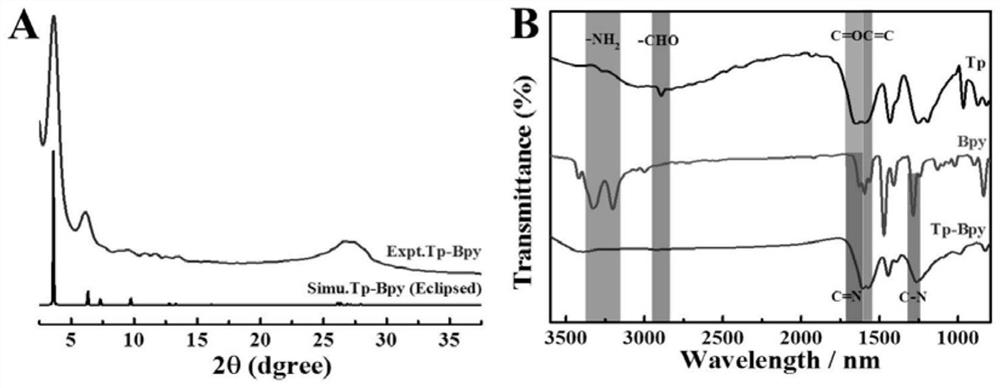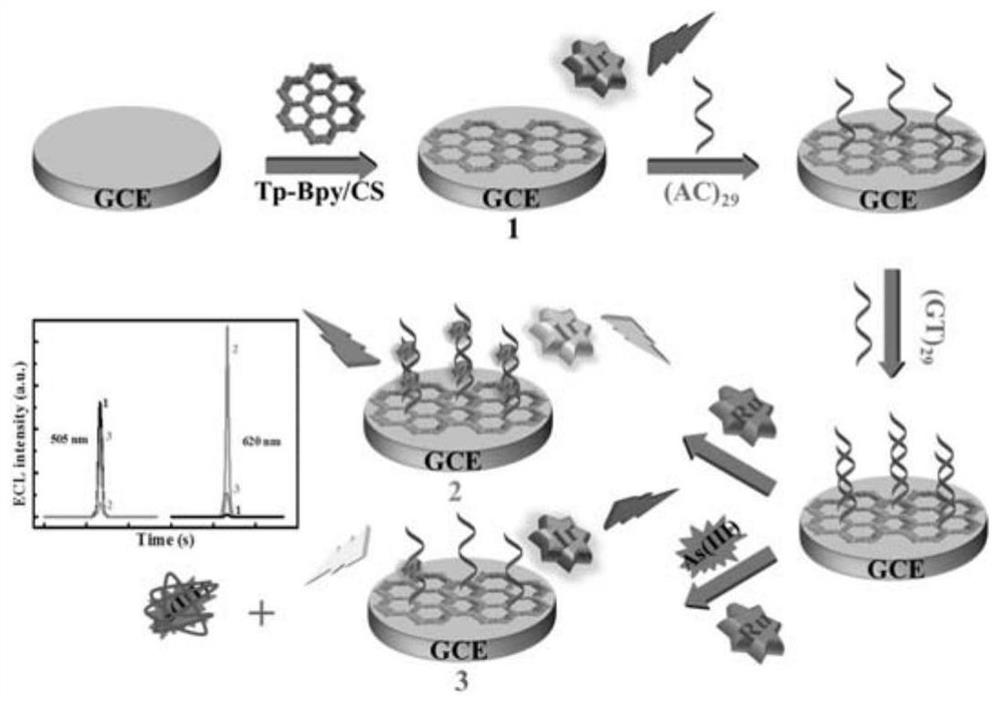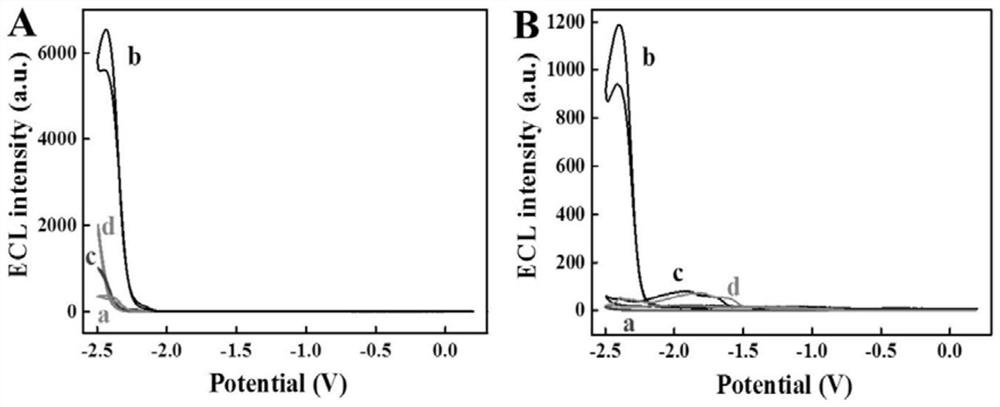Electrochemical luminescence method taking covalent organic framework as coreactant and application of arsenite radical detection
A covalent organic framework, co-reactant technology, applied in chemiluminescence/bioluminescence, electrochemical variables of materials, analysis by chemical reaction of materials, etc. , human health hazards, etc., to achieve the effect of good application prospects
- Summary
- Abstract
- Description
- Claims
- Application Information
AI Technical Summary
Problems solved by technology
Method used
Image
Examples
Embodiment 1
[0028] Preparation and Characterization of Tp-Bpy COF
[0029] Preparation of Tp-Bpy COF: first add trialdehyde phloroglucinol (Tp) and 5,5'-diamino-2,2'-bipyridine (Bpy) into a glass tube, then add 1,4-diox Alkanes, 1.0mL mesitylene and 6M acetic acid solution, the mixed solution was quickly frozen in a liquid nitrogen bath, and at the same time, the glass tube was evacuated and flame-sealed, and the sealed glass tube was placed in an oven at 120°C for 3 days. The product was washed with anhydrous tetrahydrofuran, and the obtained brown-red product was dried at 100°C for 24 hours to prepare a pyridine-containing covalent organic framework Tp-Bpy COF.
[0030] figure 1 A is the powder X-ray diffraction pattern (PXRD) of Tp-Bpy COF, Tp-Bpy COF has a strong diffraction peak at 3.6°, which is attributed to the reflection of the (100) crystal plane, at 7.2° and 26.9° The diffraction peaks were attributed to the (200) and (002) crystal planes of Tp-Bpy COF, respectively, indicati...
Embodiment 2
[0032] Coreactant effect of Tp-Bpy COF
[0033] The glassy carbon electrode was sequentially polished with 1.0, 0.3 and 0.05 μm alumina suspensions, and then ultrasonically cleaned in 0.1M nitric acid, absolute ethanol and ultrapure water for 1 minute, and the electrode surface was dried with nitrogen. 10μL 0.5mg mL -1 The mixed solution of Tp-Bpy COF and 0.002% chitosan (CS) was coated on the clean surface of GCE. 29 The single-stranded DNA was reacted in PBS (20mM pH 7.4) buffer solution for 12h, and the (AC) 29 Modified to the surface of the electrode by amide reaction, after cleaning the electrode with ultrapure water, soak the prepared electrode in a solution containing 100nM (GT) 29 Single-stranded DNA in PBS (20mM pH 7.4) buffer solution, reacted at 37°C for 30min, (GT) 29 Connected to the electrode by DNA complementary hybridization reaction, the prepared (GT) 29 / (AC) 29 / Tp-Bpy COF / GCE, the schematic diagram of the electrode modification process and the detectio...
Embodiment 3
[0037] Construction and characterization of ECL sensors
[0038] The construction process of the ECL sensor was characterized by cyclic voltammetry (CV) and alternating current impedance spectroscopy (EIS). Depend on Figure 4 A can be seen in [Fe(CN) 6 ] 3- / 4- In solution, GCE has an obvious redox peak (curve a); the peak current on Tp-Bpy COF / GCE is obviously weakened (curve b); due to (AC) 29 Single-stranded DNA has a negatively charged phosphate backbone, (AC) 29 The current on / Tp-BpyCOF / GCE further decreases (curve c); when (GT) 29 When connected to the electrode surface by DNA hybridization, the peak current is further reduced (curve d); (GT) 29 / (AC) 29 / Tp-Bpy COF / GCE in Ru(bpy) 3 2+ After reacting in the solution for 30min, because Ru(bpy) 3 2+ Positively charged, the peak current of the electrode increases slightly (curve e); when there is 10ppb As(III), the peak current of the electrode is significantly enhanced (curve f), which is due to As(III) and (GT)...
PUM
| Property | Measurement | Unit |
|---|---|---|
| Specific surface area | aaaaa | aaaaa |
Abstract
Description
Claims
Application Information
 Login to View More
Login to View More - R&D Engineer
- R&D Manager
- IP Professional
- Industry Leading Data Capabilities
- Powerful AI technology
- Patent DNA Extraction
Browse by: Latest US Patents, China's latest patents, Technical Efficacy Thesaurus, Application Domain, Technology Topic, Popular Technical Reports.
© 2024 PatSnap. All rights reserved.Legal|Privacy policy|Modern Slavery Act Transparency Statement|Sitemap|About US| Contact US: help@patsnap.com










